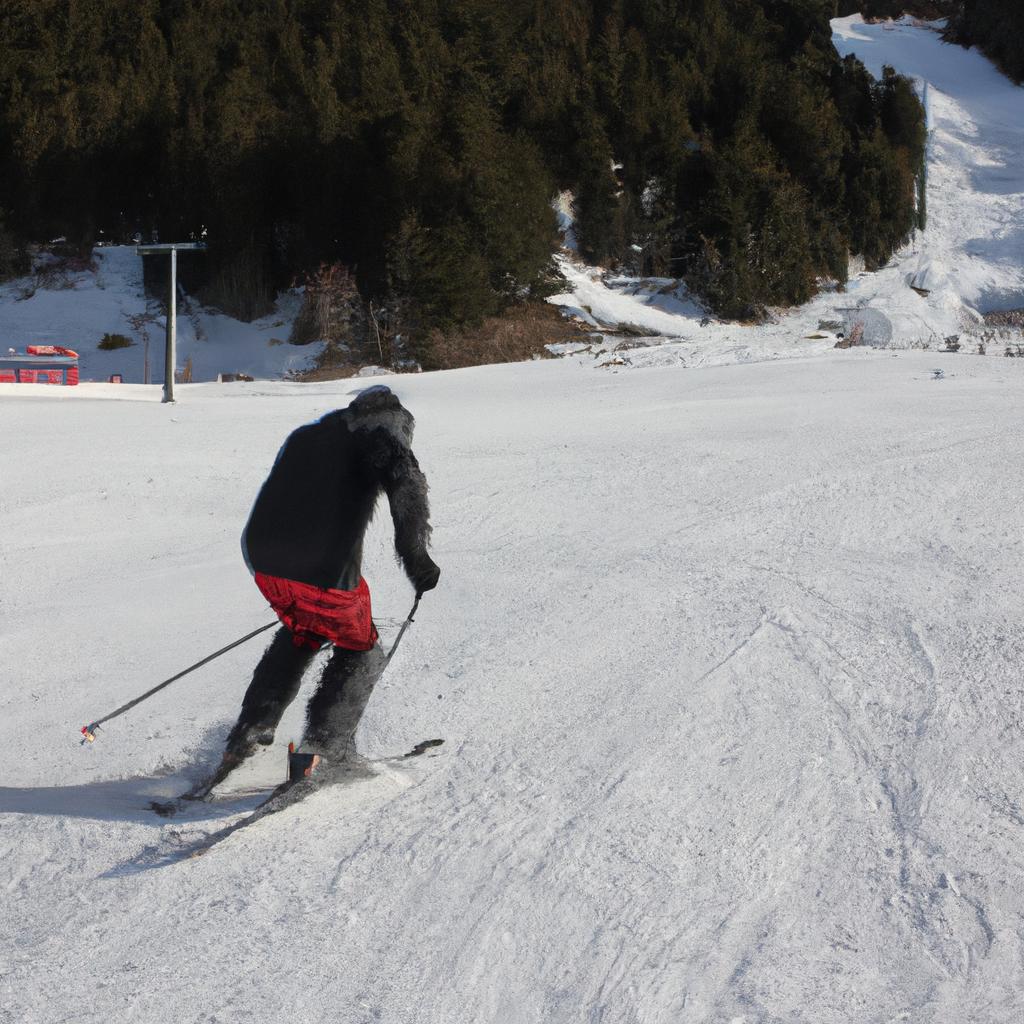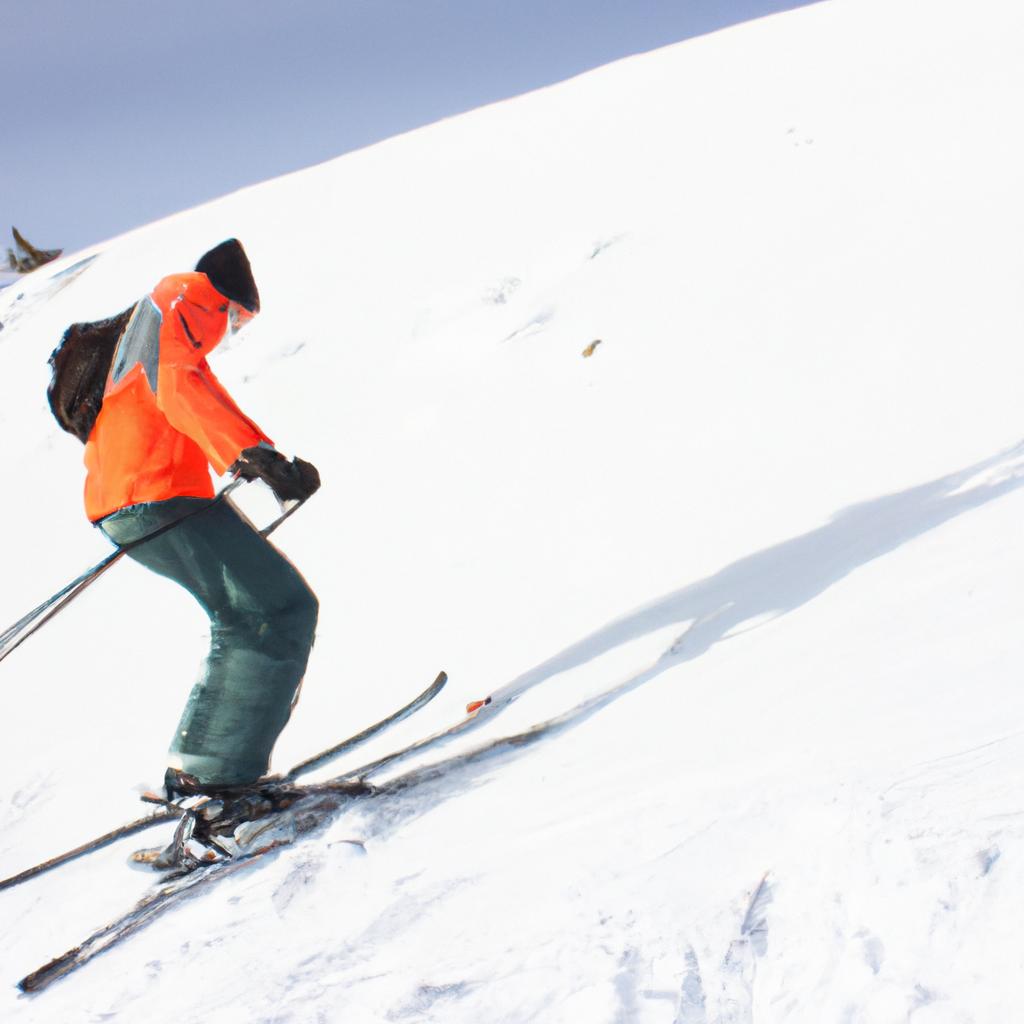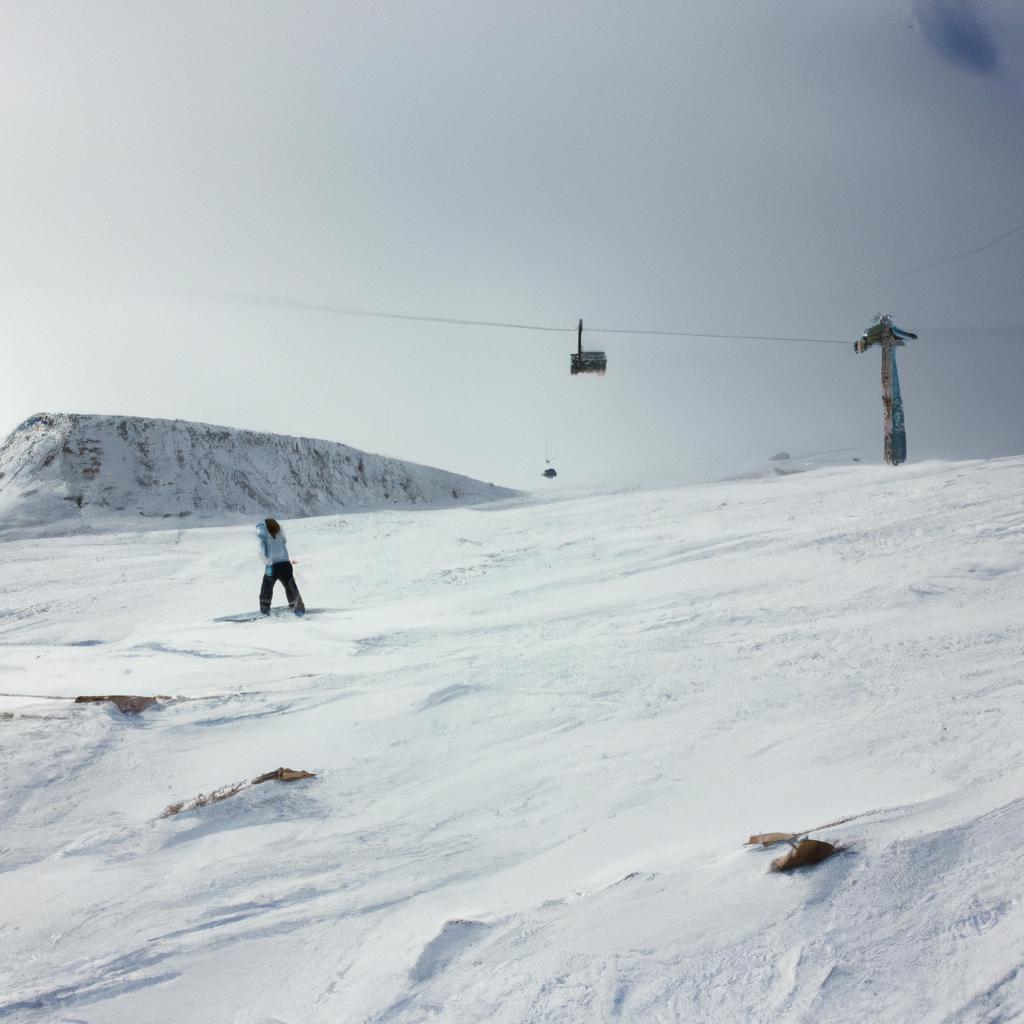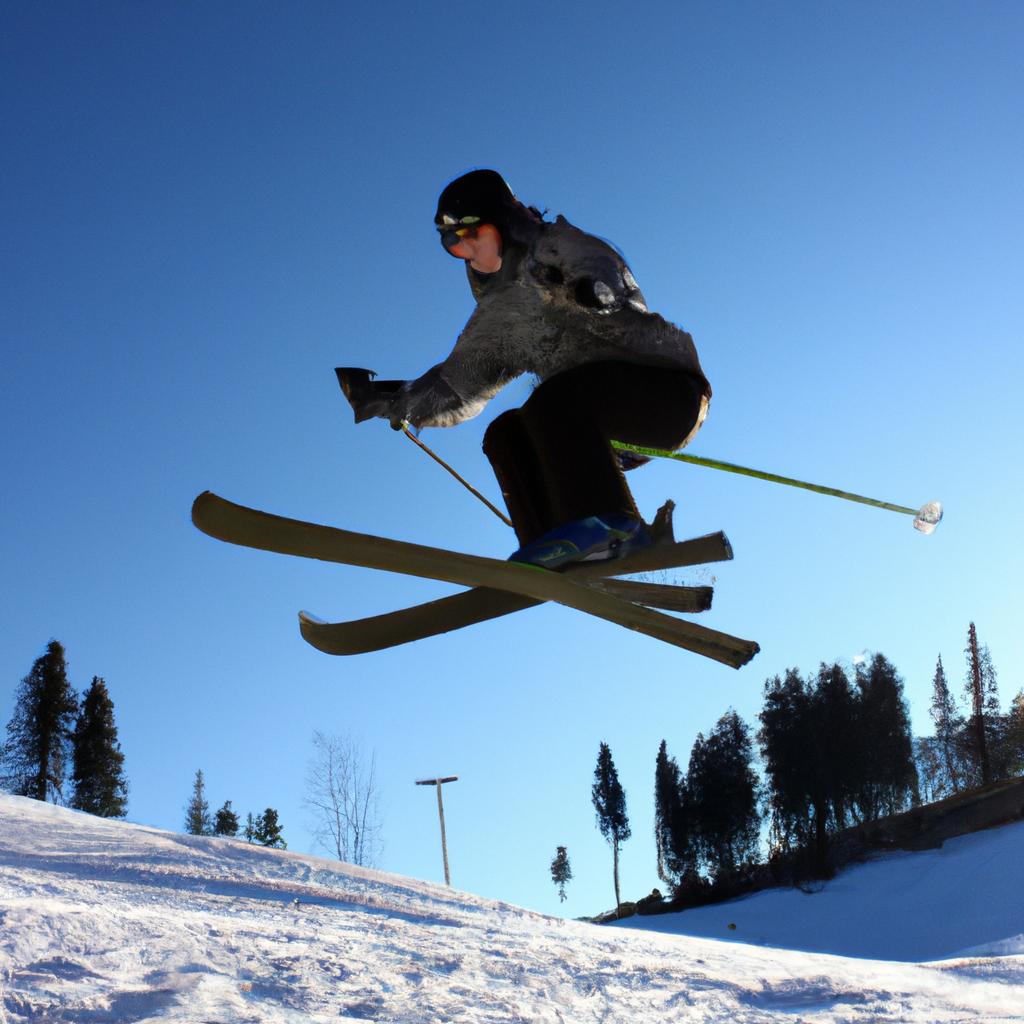Cross-country skiing, a sport that combines endurance, technique, and an appreciation for the great outdoors, has gained popularity among winter sports enthusiasts in recent years. Take the example of John, a novice skier who decided to embark on a cross-country skiing adventure during his winter vacation. As he glided through picturesque landscapes blanketed in snow, John quickly discovered the unique thrills this sport offers. In this article, we will delve into the world of cross-country skiing, exploring its exhilarating nature and highlighting why it is becoming increasingly popular in the realm of recreation and sports.
The beauty of cross-country skiing lies not only in its physical demands but also in its ability to connect individuals with their natural surroundings. Unlike downhill skiing or snowboarding which often involve crowded slopes and chairlifts, cross-country skiing provides an opportunity for solitude and tranquility amidst breathtaking winter landscapes. Whether traversing gentle rolling hills or navigating challenging terrain, skiers can immerse themselves in a serene environment while experiencing an invigorating full-body workout.
Moreover, cross-country skiing appeals to those seeking an inclusive sport that caters to various skill levels and ages. From beginners like John to seasoned athletes looking for a low-impact training option during off-seasons, this versatile activity accommod ates a wide range of participants. With proper instruction and practice, anyone can learn to cross-country ski and enjoy its benefits. The technique involved in cross-country skiing focuses on efficient movements and weight distribution, making it accessible even for individuals with limited athletic background.
Additionally, cross-country skiing offers numerous health benefits. As a cardiovascular exercise, it improves heart and lung function, promoting overall cardiovascular fitness. The continuous motion of skiing engages multiple muscle groups, including the legs, core, arms, and shoulders, resulting in improved strength and endurance. This low-impact activity also reduces the risk of joint injuries commonly associated with high-impact sports like running or basketball.
In recent years, the popularity of cross-country skiing has been further fueled by advancements in equipment and technology. Modern skis are lighter, more maneuverable, and designed to enhance glide efficiency. Specialized clothing and accessories provide insulation and protection against harsh winter conditions while allowing freedom of movement.
Furthermore, the accessibility of cross-country ski trails has increased significantly in many regions. Parks, resorts, and dedicated trail systems have expanded their offerings to cater to this growing demand. This means that enthusiasts like John can easily find suitable terrain for their skill level without having to travel long distances.
Lastly, the COVID-19 pandemic has played a role in boosting interest in outdoor activities like cross-country skiing. With social distancing measures in place and limited indoor recreational options available during winter months, people have turned to outdoor pursuits for both physical activity and mental well-being. Cross-country skiing provides an excellent opportunity for individuals to stay active while enjoying fresh air and natural surroundings.
In conclusion, cross-country skiing is gaining popularity among winter sports enthusiasts due to its combination of physical challenge, connection with nature, inclusivity across skill levels and ages, health benefits, technological advancements in equipment, increased accessibility of trails systems worldwide as well as being a safe option during the pandemic. Whether you’re a novice or an experienced skier, cross-country skiing offers a unique and thrilling way to embrace the winter season while reaping the rewards of an engaging outdoor activity.
Choosing the Right Cross-Country Skis
Imagine yourself standing at the base of a snowy mountain, surrounded by breathtaking landscapes. You are eager to embark on a cross-country skiing adventure, but before you can hit the trails, it is crucial to choose the right pair of skis. The selection process may seem daunting with numerous options available in the market, each designed for specific conditions and skill levels. In this section, we will explore key factors to consider when choosing cross-country skis.
Firstly, determining your skiing style and experience level is essential in selecting appropriate skis. Are you a beginner looking for stability and ease of use? Or perhaps an experienced skier seeking high-performance equipment for challenging terrains? Understanding your abilities and goals will guide you towards making an informed decision.
Secondly, terrain plays a significant role in ski selection. Different types of snow demand different properties from skis. For instance, if you often encounter icy or hard-packed trails, opt for skis with sharper edges and stiffer flex characteristics to enhance grip. On the other hand, softer flexing skis are ideal for powder or fresh snow as they provide better flotation.
Thirdly, pay attention to ski length as it directly affects maneuverability and performance. Longer skis offer more stability and gliding efficiency while shorter ones excel in agility and turning ability. Consider your height, weight, and intended use to find the optimal length that suits your needs.
Lastly, let’s not forget about bindings—the interface between your boots and skis— which must be compatible with one another. Ensure that both bindings and boots have corresponding compatibility standards such as NNN (New Nordic Norm) or SNS (Salomon Nordic System). This ensures secure attachment without compromising safety during your skiing endeavors.
In summary, choosing the right cross-country skis involves considering various factors such as skiing style, terrain conditions, ski length suitability based on personal attributes like height and weight, and compatibility between bindings and boots. By carefully assessing these factors, you can enhance your skiing experience and maximize enjoyment on the trails.
Transitioning into the subsequent section about “Mastering the Basic Techniques of Cross-Country Skiing,” let’s now delve into the fundamental skills required to navigate the snowy landscapes with finesse.
Mastering the Basic Techniques of Cross-Country Skiing
Imagine yourself standing at the base of a snow-covered hill, ready to embark on an exhilarating cross-country skiing adventure. As you push off with your poles and glide effortlessly across the pristine white surface, you feel a sense of freedom and connection with nature like never before. But before you can fully immerse yourself in this thrilling sport, it is essential to master some basic techniques that will ensure both safety and enjoyment on the trails.
To begin your journey towards becoming a proficient cross-country skier, let’s explore three fundamental techniques that form the foundation of this graceful and dynamic sport:
-
Diagonal Stride: The diagonal stride is the most common technique used in cross-country skiing. It involves pushing off with one ski while simultaneously gliding forward with the other foot. This movement creates a fluid motion akin to walking or running on skis. Maintaining balance and rhythm is crucial for efficiency and stability throughout each stride.
-
Double Poling: When faced with flat or slightly downhill terrain, double poling becomes essential. In this technique, both poles are planted firmly into the snow as you propel yourself forward using upper body strength primarily. Proper coordination between arm movements and weight transfer from leg to leg ensures smooth execution.
-
Snowplow Turn: For those challenging descents or tight turns, mastering the snowplow turn is vital for control and maneuverability. By forming a “V” shape with your skis and applying pressure against their inner edges, you create resistance against gravity that slows down your speed while guiding you safely around corners.
Now that we have explored these foundational techniques let us delve deeper into understanding different types of cross-country skiing trails in our subsequent section about “Exploring the Different Types of Cross-Country Skiing Trails.” Remember, by honing these skills through practice and perseverance, you will be well-prepared to tackle the varied terrains and experience the delights that await you on your cross-country skiing journey.
Exploring the Different Types of Cross-Country Skiing Trails
Imagine this: you’re standing at the base of a snow-covered mountain, ready to embark on a thrilling cross-country skiing adventure. As you strap on your skis and take that first glide forward, you can’t help but feel an adrenaline rush. But where should you go? What types of trails are available for cross-country skiing enthusiasts like yourself? Let’s explore some of the different options.
Firstly, there are groomed trails designed specifically for cross-country skiing. These trails are meticulously maintained by grooming machines, ensuring a smooth and even surface for skiers to traverse. Groomed trails are often marked with signs indicating difficulty levels, allowing skiers to choose routes that match their skill level. Whether you’re a beginner or an advanced skier looking for a challenge, these well-groomed trails provide an ideal setting to enjoy the sport.
In addition to groomed trails, backcountry skiing offers a whole new realm of exploration. In this type of skiing, adventurers venture off-trail into unmarked terrain, embracing the thrill of untouched wilderness. Backcountry skiing requires specialized equipment such as touring skis and climbing skins which allow skiers to ascend slopes before descending them. This form of skiing provides a sense of freedom and solitude as one immerses themselves in nature’s beauty while conquering challenging terrains.
For those seeking cross-country skiing experiences infused with cultural heritage, Nordic ski centers offer designated trail systems that showcase local traditions and history. These centers often feature tracks through picturesque landscapes dotted with historic landmarks or traditional villages. Skiers have the opportunity to explore not only the physical aspects but also delve into the rich stories behind each location they encounter along their journey.
Now let’s evoke an emotional response by considering how engaging in cross-country skiing can benefit our overall well-being:
- The serenity experienced amidst vast snowy landscapes fosters inner peace.
- The physical exertion of skiing activates endorphins, enhancing mood and reducing stress.
- Connecting with nature promotes a sense of grounding and mindfulness.
- Overcoming challenges on the trails builds resilience and boosts self-confidence.
To further engage our audience, let’s present this information in an easy-to-digest format using a table:
| Benefit | Emotional Response |
|---|---|
| Inner peace | Tranquility |
| Enhanced mood | Happiness |
| Grounding and mindfulness | Sense of serenity |
| Resilience and self-confidence | Empowerment |
In conclusion, cross-country skiing offers various types of trails to cater to different preferences. From groomed trails for smooth glides to backcountry adventures for thrill-seekers, there is something for everyone. Additionally, Nordic ski centers provide opportunities to immerse oneself in local culture while enjoying the sport. As we explore these diverse trail options, it becomes evident that cross-country skiing not only provides physical benefits but also contributes significantly to our emotional well-being.
Transitioning into the subsequent section about “Staying Safe and Prepared While Cross-Country Skiing,” it’s vital to prioritize safety amidst all the excitement. By following essential guidelines and being well-prepared, you can fully enjoy your cross-country skiing experience without compromising your well-being.
Staying Safe and Prepared While Cross-Country Skiing
Imagine you are standing at the trailhead, eager to embark on a cross-country skiing adventure. As you survey the landscape before you, it becomes apparent that not all trails are created equal when it comes to this exhilarating sport. Each type of cross-country skiing trail offers its own unique challenges and rewards.
One example of a popular cross-country skiing trail is the groomed track. These trails are meticulously maintained with special grooming equipment, ensuring smooth and even surfaces for skiers. The tracks are typically set in parallel lines, allowing skiers to follow them effortlessly. Groomed tracks provide an excellent introduction to cross-country skiing for beginners, as they offer stability and predictability.
On the other hand, if you seek a more rugged experience, ungroomed or backcountry trails might be your preferred choice. These trails take you off the beaten path into pristine wilderness areas where nature reigns supreme. While these trails can be challenging due to uneven terrain and natural obstacles like fallen trees or rocks, they offer a sense of adventure and solitude that cannot be replicated elsewhere.
Now let’s explore some emotional aspects related to cross-country skiing:
- Freedom: Gliding through untouched snow-covered landscapes gives you a sense of freedom unparalleled by any other winter activity.
- Serenity: The silence that surrounds you while skiing allows your mind to find peace amid the hustle and bustle of daily life.
- Connection with nature: Being surrounded by breathtaking scenery reminds us of our connection with the natural world.
- Accomplishment: Overcoming physical challenges such as steep hills or difficult conditions can give rise to a profound sense of accomplishment.
Furthermore, consider the following table showcasing different types of cross-country ski trails:
| Trail Type | Description |
|---|---|
| Groomed | Meticulously maintained tracks offering smooth and predictable surfaces |
| Ungroomed | Natural trails in backcountry areas with uneven terrain and obstacles |
| Ski resorts | Trails within ski resorts that cater to both beginners and experts |
| Multi-use | Shared trails with other winter activities like snowshoeing or hiking |
In summary, cross-country skiing offers a variety of trail options catering to different preferences. Whether you crave the stability of groomed tracks or prefer the challenge and serenity of ungroomed trails, there is a perfect trail waiting for you out there.
Transitioning into the subsequent section about “Getting Started with Cross-Country Skiing: Essential Gear and Clothing,” let us now delve into the necessary equipment needed to embark on your cross-country skiing journey.
Getting Started with Cross-Country Skiing: Essential Gear and Clothing
Exploring the Thrills of Cross-Country Skiing
Imagine gliding through a picturesque winter landscape, the crisp air filling your lungs as you propel yourself forward on skis. This invigorating experience is just one example of the thrills that cross-country skiing has to offer. In this section, we will delve deeper into the sport by exploring essential gear and clothing needed to get started.
To fully enjoy cross-country skiing, it is crucial to have the right equipment. Here are some key items to consider:
- Skis: Choose skis that match your skill level and intended terrain. Longer skis provide better stability for beginners, while shorter ones offer more maneuverability.
- Boots: Opt for boots that fit snugly but comfortably, providing support and insulation against the cold weather.
- Bindings: The bindings connect your boots to the skis and should be compatible with both.
- Poles: Select poles with appropriate length and grip material for optimal balance and propulsion.
In addition to these essentials, proper clothing plays a vital role in ensuring comfort and safety during your cross-country skiing adventures. Consider the following tips when dressing for your outing:
- Layer up: Wear moisture-wicking base layers followed by insulating mid-layers such as fleece or down jackets.
- Don’t forget accessories: Protect extremities by wearing thermal socks, gloves or mittens, hats, and neck gaiters or scarves.
- Eye protection: Shield your eyes from glare and UV rays with sunglasses or goggles designed for snow sports.
- Stay visible: Choose brightly colored outerwear or wear reflective bands so others can easily spot you on the trails.
To further engage our audience emotionally, let’s take a closer look at how cross-country skiing offers various benefits beyond its recreational aspects:
| Benefit | Description | Example |
|---|---|---|
| Physical Fitness | Cross-country skiing is a whole-body workout that enhances cardiovascular fitness, muscle strength, and endurance. | Imagine effortlessly gliding across the snow while feeling your muscles engage in every movement. |
| Mental Well-being | The serene winter landscapes combined with physical activity can have a positive impact on mental health by reducing stress and boosting mood. | Picture yourself surrounded by tranquil snowy scenery as you ski through peaceful trails, leaving behind the worries of daily life. |
| Social Interaction | Cross-country skiing provides an opportunity to connect with like-minded individuals or participate in group activities such as races or guided tours. | Envision joining a cross-country ski club where you can meet fellow enthusiasts, share experiences, and form lasting friendships. |
As we conclude this section on essential gear and clothing for cross-country skiing, it is important to note that being properly equipped will enhance both safety and enjoyment throughout your adventures on the snow-covered terrain.
Transitioning seamlessly into the subsequent section about “Benefits of Cross-Country Skiing for Physical Fitness,” let us now delve into how participating in this rewarding sport can positively impact our overall well-being.
Benefits of Cross-Country Skiing for Physical Fitness
Exploring the Scenic Delights: Cross-Country Skiing Trails
Imagine gliding through a winter wonderland, surrounded by snow-covered trees and glistening landscapes. This is the allure of cross-country skiing – an exhilarating sport that allows you to explore nature’s beauty while engaging in physical activity. As you venture further into the world of cross-country skiing, one aspect that will captivate your attention is the wide array of trails available for this sport.
One example of a captivating cross-country ski trail is the Kancamagus Highway in New Hampshire, USA. Nestled within the White Mountains National Forest, this trail offers breathtaking views as it winds its way through picturesque valleys and over scenic mountain passes. Skiers can immerse themselves in the tranquility of nature while enjoying the challenges presented by varying terrains and elevations.
To fully appreciate the diversity of cross-country skiing trails worldwide, consider these notable features:
- Terrain variety: From gentle slopes suitable for beginners to steep inclines designed for advanced skiers seeking a thrill, cross-country ski trails cater to all skill levels.
- Scenic vistas: Many trails are strategically located to offer stunning panoramic views or access to natural landmarks such as frozen lakes or cascading waterfalls.
- Accessibility: Some trails feature well-maintained paths with easy access points and facilities like rest areas or warming huts along the route.
- Trail networks: In certain regions, interconnected trail systems allow skiers to embark on extended expeditions or customize their routes based on preferred distances.
To help you navigate different aspects of various cross-country ski trails more efficiently, we present below a table summarizing some popular destinations around the globe:
| Destination | Country | Length (km) | Difficulty Level |
|---|---|---|---|
| Gatineau Park | Canada | 200 | Beginner-Friendly |
| Vasaloppet | Sweden | 90 | Advanced |
| Engadin Skimarathon | Switzerland | 42 | Intermediate |
| Yellowstone National Park | USA | 150 | Varied |
As you explore these trails, remember that safety is paramount. Always check weather conditions and trail reports before embarking on your journey. Additionally, respect the environment by adhering to any guidelines or regulations in place.
In summary, cross-country skiing offers not only a physically invigorating experience but also an opportunity to immerse oneself in awe-inspiring natural surroundings. With a multitude of trails available worldwide, each with its own unique features and challenges, skiers can discover new destinations while indulging their passion for this exhilarating sport. So gear up, find your perfect trail, and embark on an adventure that will leave you breathless – both from the physical exertion and the breathtaking beauty surrounding you.
 Buzzez
Buzzez



